 At a glance
At a glance
Expert’s Rating
Pros
- 12 top-end ports, including four Thunderbolt 5
- Built-in fast M.2 NVMe SSD
- 2.5Gb Ethernet
- Fast card readers
- 140W Power Delivery
Our Verdict
Thunderbolt 5 is the future for pro Macs, and this premium docking station boasts four TB5 ports plus a built-in SSD of up to 4TB.
Price When Reviewed
This value will show the geolocated pricing text for product undefined
Best Pricing Today
Price When Reviewed
From $399.99
Best Prices Today: Sonnet Echo 13 Thunderbolt 5 SSD Dock
Evwr since we tested it, our favorite docking station for Mac has been the the Sonnet Echo 20 Thunderbolt 4 SuperDock. It has just about everything: 19 top-end ports, 2.5Gb Ethernet, and a slot to add your own SSD drive to discreetly boost your MacBook’s internal storage without a big box hanging out the back.
Sonnet has now released its super-dock for Thunderbolt 5: The Echo 13 Thunderbolt 5 SSD Dock. It has dropped the “SuperDock” moniker but it’s even more super than its predecessor.
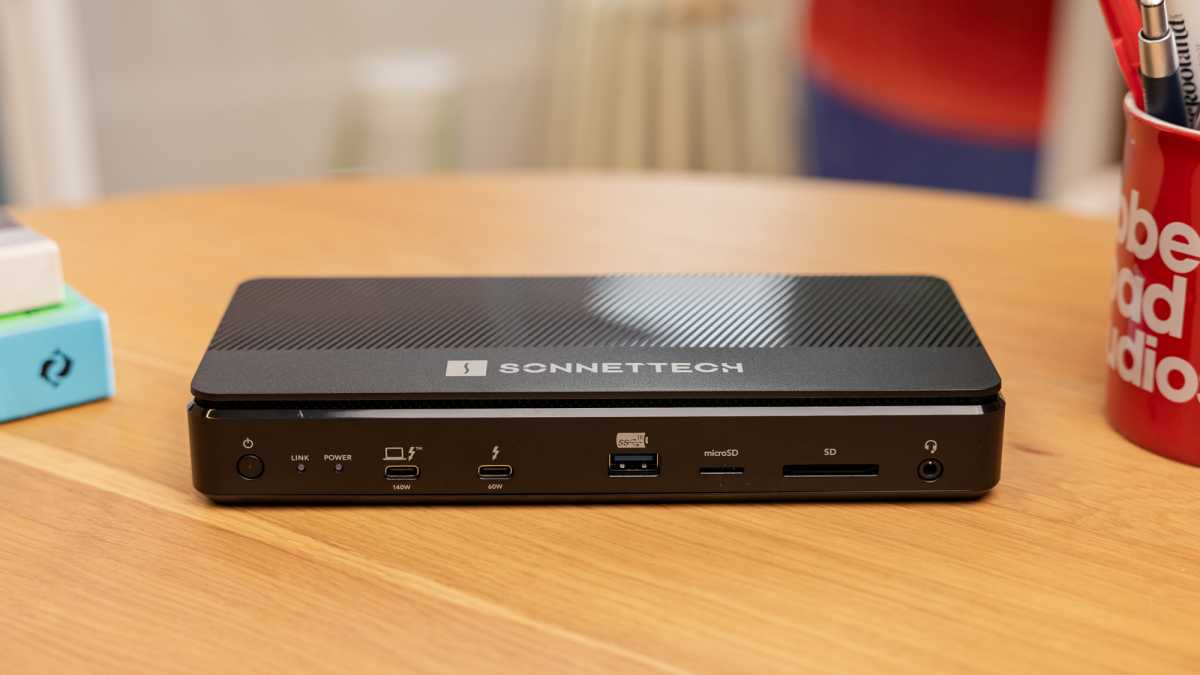
Dominik Tomaszewski / Foundry
Echo 13 Thunderbolt 5 SSD Dock: Specs and features
Any docking station has to be judged first and foremost on the ports and features that it offers the connected laptop/desktop/iPad Prouser.
The Sonnet Echo 13 doesn’t have as many ports as the TB4 SuperDock, and, just as the Echo 20 had 19 ports, the Echo 13 has 12 ports, not including the power port.
- One upstream Thunderbolt 4 port (80Gbps, 140W)
- Three downstream Thunderbolt 5 ports (80Gbps, 1x 60W, 2x 15W)
- Two USB-A ports (10Gbps, 7.5W)
- One USB-A port (5Gbps, 7.5W)
- Internal M.2 NVMe SSD (1TB / 2TB / 4TB)
- Ethernet (2.5Gb)
- UHS-II SD card reader (312MBps)
- UHS-II microSD card reader (312MBps)
- 3.5mm combo audio jack (front)
- 180W power supply
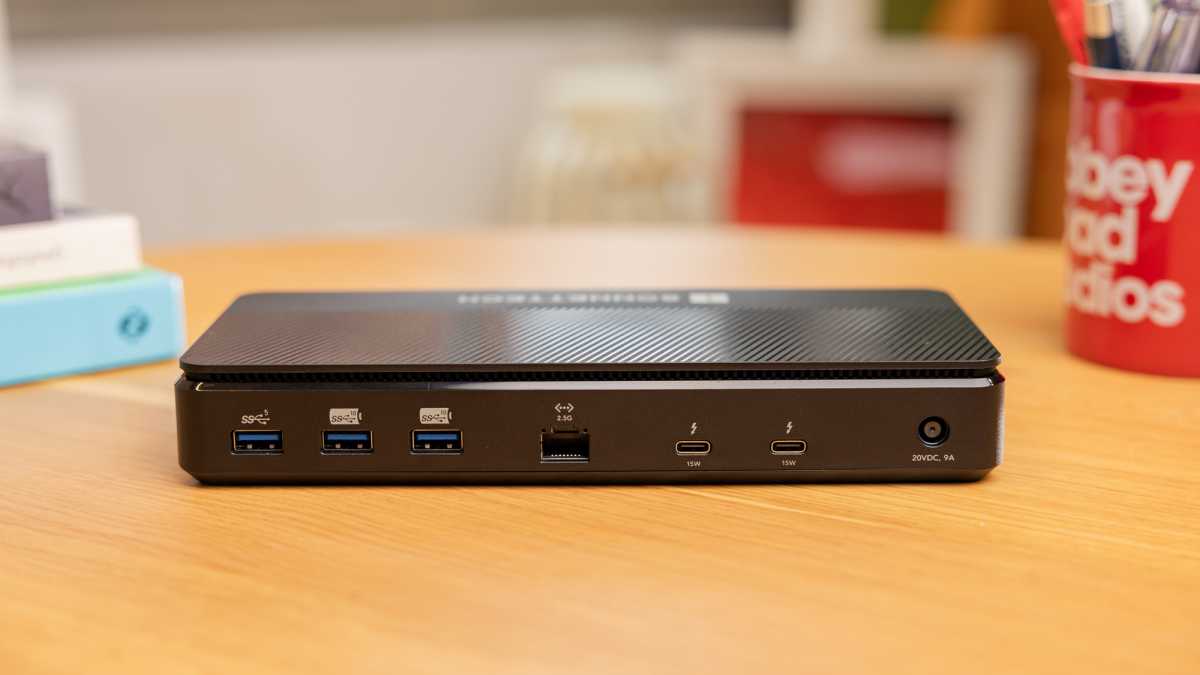
Dominik Tomaszewski / Foundry
Echo 13 Thunderbolt 5 SSD Dock: Thunderbolt speeds
When Thunderbolt elbowed Thunderbolt 3 out of the way in 2020, Mac users could be forgiven for shrugging their shoulders with its top-end data-transfer speed staying at 40Gbps. In many ways, Thunderbolt 4 was a certification upgrade for Windows computers. Apple’s Intel-certified Thunderbolt 3 had most of what TB4 brought to the party, with a few pro benefits thrown in (i.e., support for dual 4K displays or one 8K display).
Thunderbolt 5, on the other hand, is a proper update for all users, boosting data speeds to bi-directional 80Gbps and up to 120Gbps in boost mode for higher display bandwidth. That means much faster data transfers between devices and your Mac compared to Thunderbolt 4. TB5 has a mandated higher power delivery (to a laptop) of at least 140W (up from 100W) with support for up to 240W (vs 140W).
The Echo 13 can power your MacBook at 140W (PD 3.1), which is enough to fast-charge the top-end 16-inch MacBook Pro via its upstream host TB5 port. The front-facing downstream Thunderbolt 5 port can charge at a powerful 60W, and the two back-mounted downstream TB5 ports can charge at 15W. Thunderbolt 5 also supports three 4K, 144Hz displays on Mac, compared to TB4’s base two 4K displays at 60Hz.
You’ll need a Mac with Thunderbolt 5 to get the best value—available on the M4 Pro/Max MacBook Pro, M4 Pro Mac mini, and Mac Studio—but as it is backward compatible with Thunderbolt 4 and earlier, buying a TB 5 dock now will future-proof you for your next Mac purchase.
Echo 13 Thunderbolt 5 SSD Dock: Design
While made from plastic, the sleek, black horizontal Sonnet Echo 13 looks impressive—maybe not as high-end as docks in metal casings, but still good enough next to your Mac. On the front, there’s a handy power button so you don’t need to yank out the Thunderbolt 5 cable when leaving your laptop overnight. Next to that are indicator lights to show when the dock is linked to a computer and when it is powered.
All the ports are clearly labeled, which is appreciated. The upstream Thunderbolt 5 port is on the front, which is not our preference as we like it hidden at the back, but this setup might suit others. A downstream Thunderbolt 5 port—with 60W charging power—sits next to the host port, followed by a 10Gbps USB-A port. The two card readers for portable storage are handily placed on the front, as is the headset jack.
Around the back, there is a row of three legacy USB-A ports—one at 5Gbps and two at 10Gbps—and then the 2.5G Ethernet. Two more downstream Thunderbolt 5 ports round off the back panel. There’s also a slot for a Kensington Security Lock on the side and anti-slip rubber feet at the bottom. There are air vents at the top of the dock, which kept it cool during our tests.
Echo 13 Thunderbolt 5 SSD Dock: USB ports
Thunderbolt 5 is more speed than most devices need, which is why the dock comes with a bunch of standard USB ports as well. There aren’t any USB-C ports since the Thunderbolt ports are compatible with all type-C connectors, but there are four legacy USB-A ports, which is plenty in today’s USB-C world. We would have preferred a couple of those USB-A ports to be USB-C, but there are enough data and charging options here to satisfy most setups.
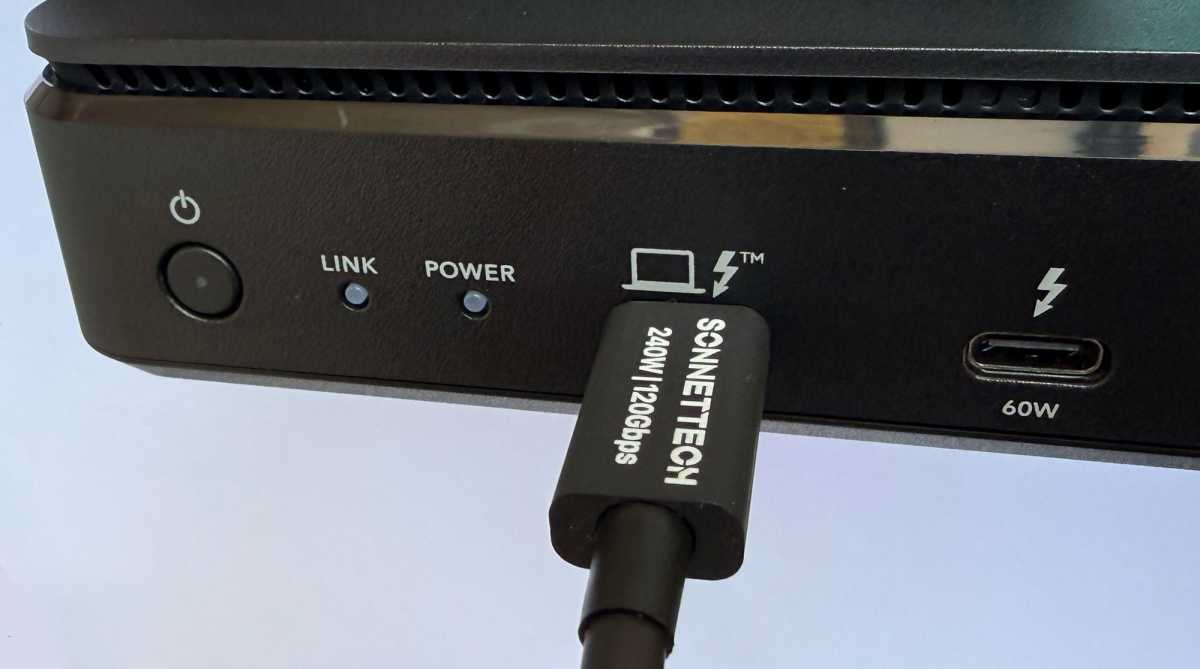
Simon Jary / Foundry
Power is supplied to the connected laptop at 140W. With a maximum 180W available from the external power supply, you won’t get the full 140W plus the generous 60W from the neighboring downstream TB5 port but potentially both of the other two TB5 ports at 15W each. A higher-powered power supply would have been preferred as no doubt the dock itself including the SSD storage will require some juice itself in normal operation.
Echo 13 Thunderbolt 5 SSD Dock: Display options
You can connect up to two external displays via the Echo 13 Dock. There are no dedicated DisplayPort or HDMI ports, so if your monitor requires either of these two video connectors you’ll need to buy a USB-C adapter cable. If you own a USB-C monitor, you can connect directly with one of the downstream TB ports.
On the TB4 Echo 20 Sonnet dropped one of the possible downstream TB4 ports for an HDMI 2.1 port, but keeping the Echo 13 at three downstream TB5 ports gives the user more flexibility. A modern multi-monitor setup requires only one Thunderbolt 5 port, thanks to Thunderbolt 5’s high bandwidth and the ability of modern monitors to daisy chain and connect the additional monitor via a Thunderbolt output on the monitor itself.
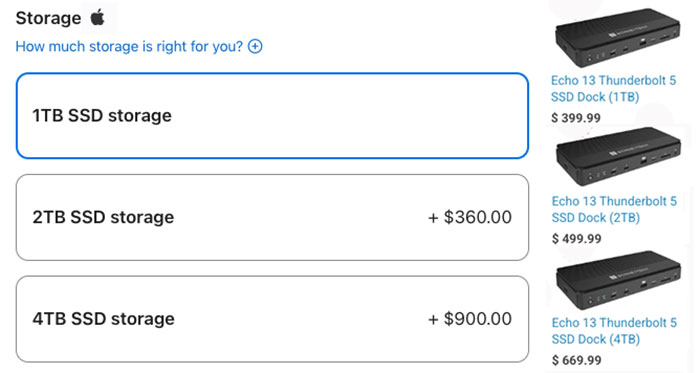
Foundry
Echo 13 Thunderbolt 5 SSD Dock: Super-fast storage options
One of the primary selling points of this Thunderbolt 5 dock is its built-in SSD storage. This is integrated rather than being a slot that you add your own SSD to, as was found in the Echo 20.
Sonnet offers SSDs at 1TB, 2TB or 4TB. Being able to fit your own SSD probably would have been a cheaper option but let’s not complain because this internal storage is not just cheaper than buying a Mac with a high-capacity drive from Apple, which would charge you an extra $400 for a 2TB internal SSD or $1,000 for 4TB. The SSD is not formatted, but it’s easy to do this yourself using the Mac’s Disk Utility.
If you do desire the extra storage you are in for a treat. The SSD is blindingly fast—much faster than you’d get with an external SSD. My colleague PCWorld’s Mark Hachman tested the Echo 13, and recorded a sequential read performance of 3,977MBps, almost double the read performance of 2,036MBps from his Lexar SL600 external 20Gbps SSD. When copying a folder of raw multimedia files from the SSD to the desktop, he recorded a copying time of just under 14 seconds—78 percent faster than the previous best time he’d seen for this test, which was over a minute.
Thomas Berghold from our German Macwelt used Aja System Test Lite to measured an impressive 5,331MBps write and 5,822MBps read in the 4K test. Compared to the speeds we’ve measured for other internal storage devices in docking stations, this class-leading performance.
Coupled with its 180W power supply the Echo 13 isn’t particularly portable, so what you store on that SSD isn’t going with you when you disconnect the MacBook from the dock. It’s great for backups, archiving, and for large files you don’t need with you on the road.
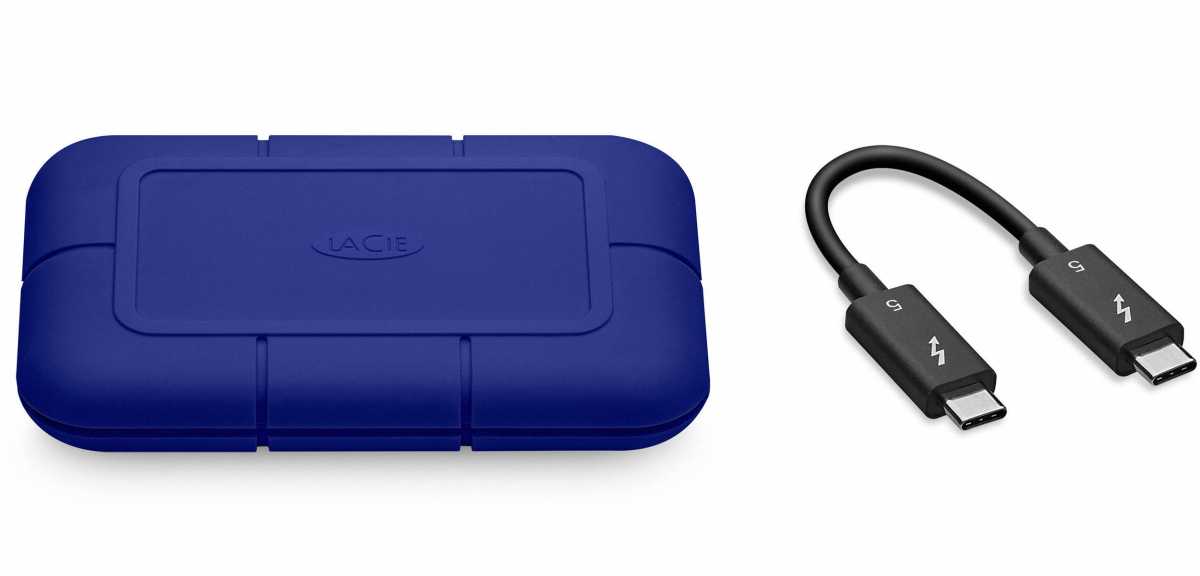
LaCie
With an external Lacie Rugged SSD Pro 5, we measured 6,094MBps read and 4,013MBps write. That’s only slightly slower than the 6,172MBps read and 4,374MBps write directly on the Mac.
A test with the OWC Express 1M2, our fastest USB 4 testing drive, yields 3,274MBps read and 3,132MBps write. Directly on the Mac, it’s 3,665MBps read and 3,257MBps write.
The Echo 13 features just both SD and microSD card readers for portable storage, an improvement on the SD-only Echo 20. Both are of the fast UHS-II variety. Measured with an OWC Atlas Ultra from our memory card test, the speeds here are also very good, with 292MBps for reading and 275MBps for writing.
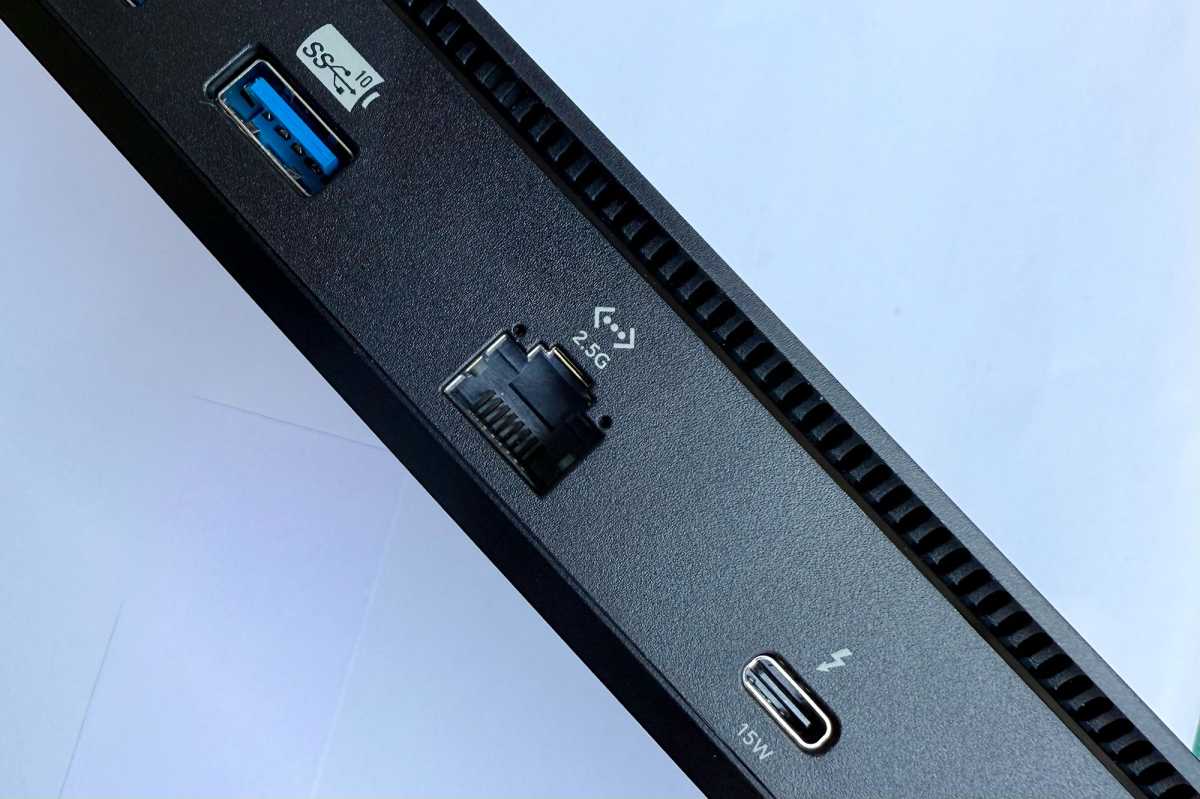
Simon Jary / Foundry
Echo 13 Thunderbolt 5 SSD Dock: Network speeds
While most networks are still rated at the standard 1Gb (Gigabit) Ethernet, more modern networks are much faster at 2.5Gb, 5Gb or even 10Gb speeds.
The Echo 13’s Ethernet port is rated at 2.5Gb, so a big speed jump on most docking stations and hubs, but not the very fastest if your network is at the cutting edge.
If you are still on Gigabit Ethernet, fear not as speedier versions are backwards compatible.
Echo 13 Thunderbolt 5 SSD Dock: Price
Sonnet doesn’t offer a model of the Echo 13 without a built-in SSD so if you really don’t need extra storage or prefer a portable solution you may be overpaying for just the dock itself. But who doesn’t need more storage, even if just for multiple backups?
The 1TB model costs $400, 2TB is priced at $500, and 4TB at $700. While pricier than docks without an SSD, the extra you pay for such fast storage makes it a great investment. At the time of writing prices in the U.K. were higher. See our price comparison box for the latest live prices.
Sonnet’s Echo 20 Thunderbolt 4 docking station is cheaper at $300, but you’ll need to add your own SSD card. The Echo 13 might be less flexible but it is significantly faster. For other alternatives, read our roundup of the best Thunderbolt docks for Mac.
Should you buy an Echo 13 Thunderbolt 5 SSD Dock:
We are delighted that Sonnet followed its great SSD-packing Thunderbolt 4 dock with this pro-level Thunderbolt 5 model. There are plenty of differences but the main benefits remain—including the (very fast) internal storage—and are topped up with the much faster Thunderbolt 5 data speeds and power delivery.
Even if you don’t yet own a Thunderbolt 5 computer or many devices, buying this super-speedy premium dock will future-proof you for when you do.
Additional testing by Mark Hachman and Thomas Bergbold.






